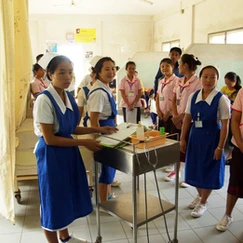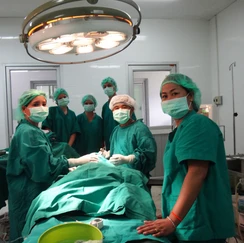An update on health in Laos
- PEMM
- Jan 24, 2023
- 7 min read
Laos is one of the poorest countries in Southeast Asia and is therefore lagging far behind in the development process. This backwardness has heavily impacted the health sector compared to developed countries.
The economic growth in Laos since the 2000s and the government's commitment to achieving the UN Millennium Development Goals has nevertheless led to a significant improvement in the Lao health system. For example, maternal mortality was reduced by 75% between 2008 and 2017.
However, Laos still faces major health challenges. Many of the Millennium Development Goals have been achieved, but the numbers remain low, especially compared to its neighbouring countries. Access to health is still unequal, with many people living in isolated or mountainous areas lacking access to health and unable to improve their health status. More specifically, much progress remains to be made in a large number of specialities such as nutrition, gynaecology-obstetrics or paediatrics. The country also continues to face epidemics of communicable diseases.
Policies to improve health in Laos:
At the national level, health has become one of the priorities of the Lao government. The National Growth and Poverty Eradication Strategy (NGPES), Laos' flagship strategic development programming document, identifies the health sector as one of four priority sectors for intervention. The revised Lao Constitution of 2015 also stipulates that the state shall strengthen public health services to take care of the health of the population with particular attention to women, children, the poor and people in isolated areas.
Several laws have also been adopted in the area of health. In 2001, a law on hygiene, disease prevention and health promotion was enacted. A multi-sectoral national plan for the prevention and control of communicable diseases was adopted in 2014. There is also the Lao Health Sector Reform for the period 2013-2025, which details an action plan for a resilient health system and universal health coverage by 2025. This reform takes into account the need for better access to health and the need for quality health services. Finally, there is the eighth health sector development plan for the period 2016-2020 which takes into account the cultural, financial and geographical obstacles faced by vulnerable groups who cannot have equitable access to health.
Although health is considered a priority. Public spending on health is, nevertheless, low. Since 1990, the resources allocated to public health by the state have fallen by more than 20%. Public and private sector health expenditure combined was 3.33% of GDP in 2000. In 2019, it was 1.98% of GDP. Similarly, Laos spent $32.41 per inhabitant on health in 2013. By comparison, Cambodia spent $75.64 and France $4864 per inhabitant in the same year.
Health services are also largely out-of-pocket and dependent on external funding. In Laos, less than 15% of people in precarious situations have health insurance.
Key health figures:
To fully understand the health context in Laos, it is important to establish the key figures that provide an overview of the health system. In 2020 in Laos, there were approximately 7,400,000 inhabitants. The population density is quite low. In 2018, there are 30.60 people per square kilometre. In comparison, in France, there are 118.27 people per square kilometre. Life expectancy has risen considerably, reflecting the significant improvement in the health care system over the decades. In 2000, life expectancy was 57 years. In 2018, women have a life expectancy of 69 years and men 65 years.
In terms of births, the birth rate in 2020 is 22 per 1000 inhabitants. Women between 15 and 50 have about 3 children in their lifetime.
Concerning deaths, in 2020, the mortality rate is 7 per 1000 inhabitants. According to the 2019 statistics, 9.02% of deaths are due to accidents or injuries, 65.34% of deaths are due to non-communicable diseases and 25.64% are due to communicable diseases (including pregnancy, childbirth and nutrition-related deaths). About 27% of deaths are attributed to cardiovascular diseases, cancers, diabetes and chronic respiratory diseases. In 2019, there are also about 500 deaths from AIDS for about 13,000 reported cases of HIV/AIDS.
The health system remains primary. When we look at the capacity of hospitals, we see that their resources are low, especially in remote areas. The number of hospital beds is low and fluctuates. It was 2.57 per 100 inhabitants in 1990; 0.90 in 2002 and 1.50 in 2012. The same is true for the number of available doctors. Laos still lacks sufficiently trained practitioners, especially in rural areas. Doctors were 0.23 per 1000 inhabitants in 1900; 0.59 in 1996; 0.35 in 2004 and 0.17 per 1000 inhabitants in 2012. In 2017, there were still only 0.37 doctors per 1000 inhabitants. Their number is therefore increasing but it is still far too low. Similarly, in 2012, there were only 0.9 nurses and midwives per 1000 inhabitants.
The skills of the health personnel are also old because Laos was a country isolated from the rest of the world and was therefore unable to take part in the exchanges essential to any progress in medicine, accumulating a significant backlog in most specialities. The new methods of intervention are therefore not acquired.
The Laotian health system remains fractured. In the future, cross-border trade and climate change will put pressure on the existing health system to prevent, monitor and control epidemics.
One of the most common communicable diseases in Laos is dengue fever. This disease is transmitted by mosquito bites, causes flu-like symptoms and can become very serious. According to the WHO, dengue is one of the fastest emerging infections, with the number of cases doubling in the last decade. In 2019 in Laos, 33,700 people contracted the virus and 59 people died. The dengue epidemic recurs every year between May and October, the hottest and wettest months of the year. In Laos, there is a need to improve the diagnosis of dengue in provincial and district hospitals and clinics to prevent the inevitable deaths.
Today, the most worrying communicable disease is obviously Covid-19, which is having a huge impact on the Laotian population, and not just on health. When Covid-19 spread around the world in 2020, Laos escaped the "first wave" by quickly confining itself, barricading the streets, closing the borders and applying barrier measures even with a very low number of cases. After that, although the borders remained closed, people were able to resume normal life. However, the conditional opening of the borders with neighbouring countries in early 2021 led to a surge in cases in Laos, from 50 positive cases to about 1600 cases in a few weeks. Today, only two deaths have been recorded, but the population is not necessarily being tested, and people with Covid-19 are not making themselves known either.
Key issues in Laos:
In addition to Covid, which remains the primary concern of every country in the world, there are medical areas in Laos that need attention. These include paediatrics, nutrition, gynaecology and women's health more generally.
Paediatrics is an area of medicine that needs a lot of improvement in Laos, as the Sustainable Development Goals for children's health have not been met. Health centres lack equipment and health staff need training on newborns, emergencies and warning signs, and common infectious diseases (ENT, pulmonary and dermatological).
In 2018, there is still a 4.7% infant and child mortality rate in Laos. It is the most affected country in Southeast Asia. In comparison, infant mortality is 0.3% in France.
Many of the diseases that children can get are related to malnutrition. The challenges of nutrition start at birth. In 2015, 17.3% of newborns were born with low birth weight (less than 2.5 kg) and in 2017, only 26.5% of newborns between 6 and 23 months of age receive a proper diet. Also, only 50% of women are initiated to breastfeeding within 1 hour after delivery.
In 2016, 43.80% of children under 5 are anaemic, 44% are stunted and 27% are underweight. Solutions are, however, in place for a proportion of children. In 2012, 61.2% of children with diarrhoea received an oral rehydration solution and in 2017, only 15.2% received zinc. It should be noted that diarrhoeal diseases remain one of the leading causes of death for children under 5 years old. It accounts for 9% of deaths among children worldwide.
Also, in 2017, 57% of newborns between 6 and 59 months receive a first dose of vitamin A and 65% of these newborns receive a second dose 6 months later. Vitamin A is important because it increases the chances of survival of newborns and reduces complications from childhood diseases.
Nutritional problems are also visible for women. In 2016, 39.7% of women of childbearing age have anaemia and 45.7% of pregnant women have anaemia. Finally, among adults aged 20-79, the prevalence of diabetes in 2019 is 6.40%. The percentage of adults with diabetes is increasing in Laos, which remains a significant problem.
In Laos, specialised training in nutrition exists, but nutrition is not integrated into the medical curriculum and therefore Lao health workers are not trained. In 2017, there were 0.1 nutritionists per 100,000 inhabitants.
Gynaecology is also a speciality where health workers need training. According to UNWomen, the UN agency for gender equality and women's empowerment, the health workforce needs to be strengthened, starting with midwives. Skilled birth attendants must be available and accessible, especially for emergency obstetric services.
Indeed, in Laos, only 40% of deliveries are attended by skilled personnel and only 0.7% of deliveries take place in "baby-friendly" facilities, which are built and equipped to take into account all the needs of a newborn. In 2005, the average number of gynaecology-obstetric interventions at the provincial level was 100, and there are still many women who continue to give birth at home.
Maternal mortality is still very high. As with infant mortality, Laos is the most affected country in Southeast Asia. It varies between rural and urban areas, but maternal mortality is 185 per 100,000 births in 2019. For comparison, in France, maternal mortality is 8 per 100,000 births.
Pregnancy among young women, and even teenagers, is also significant. In 2015, 10% of young women aged between 15 and 19 gave birth to a child. Nevertheless, in 2017, 72% of women of childbearing age (15-49) are satisfied with family planning and related modern methods, which is relatively high.
Finally, an estimated 3,000 women are living with HIV in Laos, of whom about 1,100 are known and half are receiving free antiretroviral treatment through the national HIV programme. There is also no routine screening for precancerous lesions and cervical cancer, neither by cervical smear nor by HPV DNA testing for HIV-infected women.
More generally, UNWomen considers that the improvement of the status of women in Laos must take place through improved primary health care, sexual and reproductive health and nutrition services. A report was drawn up in 2009 which concluded that although there have been improvements in access to health care for women or in the reduction of maternal and infant mortality, the figures are still too high, especially in rural areas. The main concern is the situation of women in the remote and mountainous areas of Laos, which represent the majority of women. They are mostly in a precarious situation, illiterate, have no access to health, education or social services, and are also in need of basic health services,
obstetric services and family planning.
Translated by Maïwenn Swanson











Comments